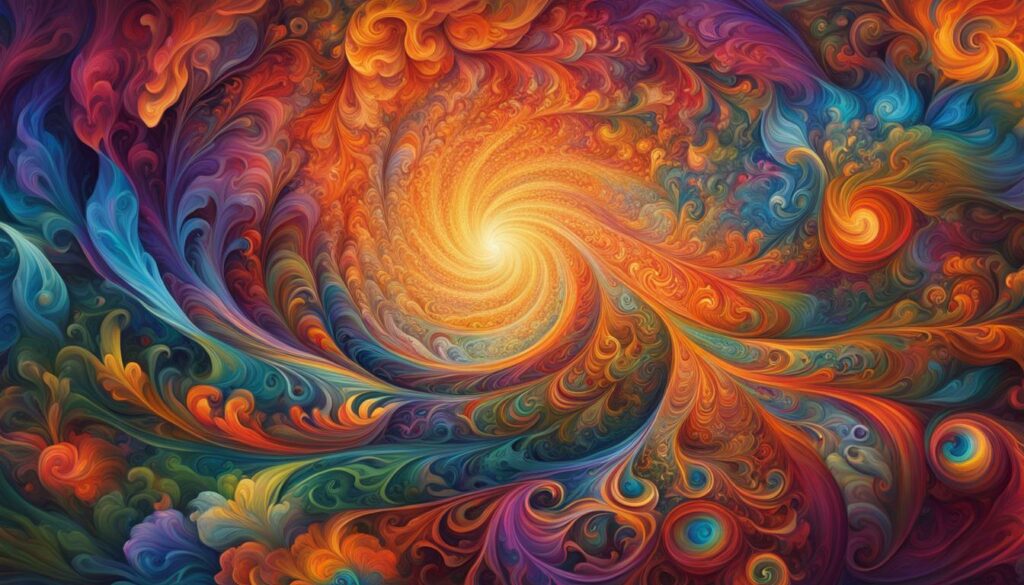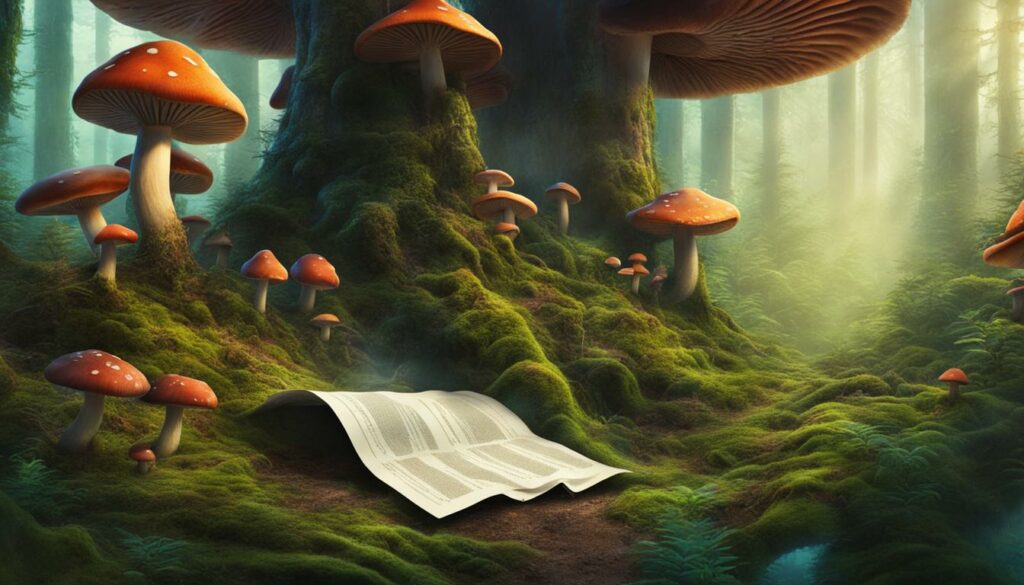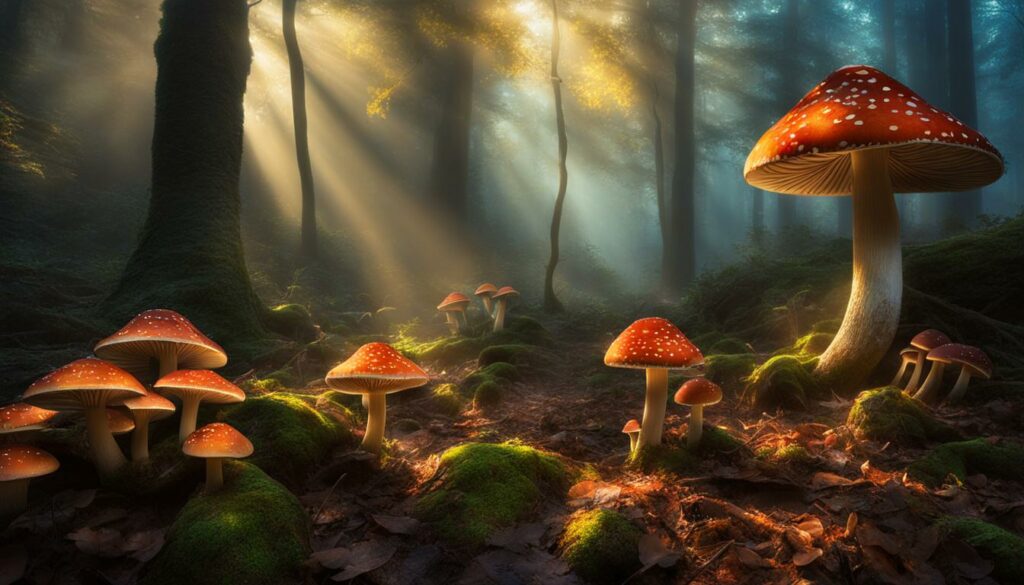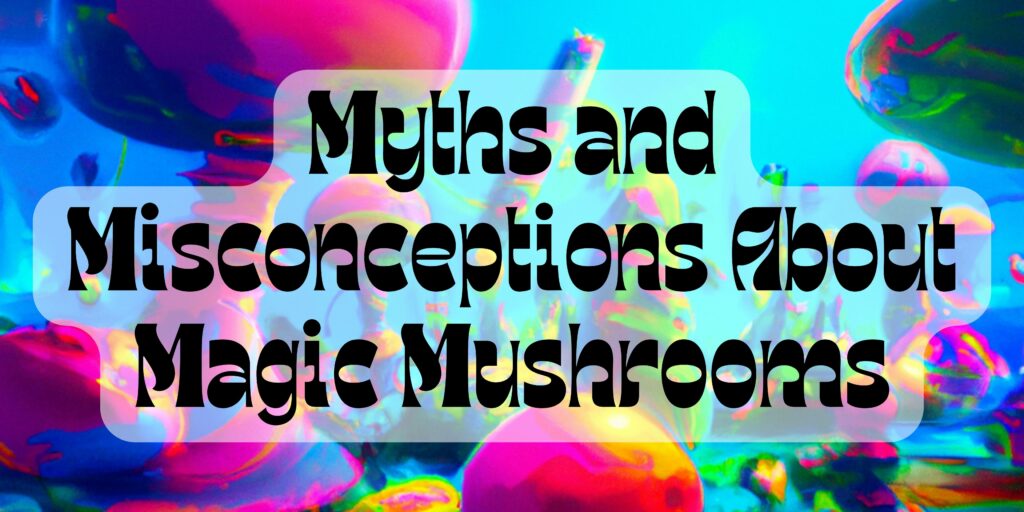Are you curious about the duration of a shroom trip? Wondering how long the effects of shrooms last? Look no further! In this article, we will explore the duration of a shroom trip and provide you with valuable insights into the effects, factors affecting the duration, potential therapeutic uses, risks, and legal status of shrooms.
Key Takeaways:
- The effects of shrooms typically last for 4-6 hours, with peak effects occurring around 2-3 hours after ingestion.
- The duration of a shroom trip can vary depending on factors such as dosage, individual metabolism, and method of ingestion.
- Psilocin, a metabolite of psilocybin found in shrooms, can be detected in urine samples for up to 24 hours after ingestion.
- Shrooms are hallucinogenic substances that can cause significant changes in perception, mood, and thought patterns.
- Shrooms have potential therapeutic uses, but research is still in the early stages, and they are not widely available or legal for everyone.
The Effects of Shrooms on the Mind and Body
Shrooms, also known as magic mushrooms, are hallucinogenic substances that can have profound effects on the mind and body. When ingested, these mushrooms interact with serotonin receptors in the brain, leading to significant changes in perception, mood, and thought patterns.
The duration of the effects of magic mushrooms can vary depending on factors such as the dosage, the individual’s mentality, and the strength of the mushrooms. Typically, the effects of a shroom trip can last for several hours, with peak effects occurring around 2-3 hours after ingestion. During this time, individuals may experience sensory distortions, visual hallucinations, mood swings, and altered thought processes.
Shrooms can induce feelings of euphoria, increased energy, and hallucinations. However, they can also have potential risks and side effects, including headaches, chills, and even diarrhea. It’s essential to approach shroom use responsibly and be aware of the potential risks involved.
It’s important to note that the effects of magic mushrooms are highly individualized and can vary from person to person. Factors such as the strength of the dosage, the person’s metabolism, and their mental state can all contribute to the intensity and duration of the trip. It’s crucial to use shrooms in a controlled setting and to be mindful of personal safety and well-being.
| Effects of Shrooms | Duration |
|---|---|
| Visual hallucinations | Varies |
| Euphoria | 4-6 hours |
| Mood swings | 2-3 hours |
| Altered thought processes | Varies |
While there is ongoing research into the potential therapeutic uses of psychedelics such as shrooms, it’s important to approach their use with caution. Shrooms are illegal in most countries and can have legal consequences. If you have any concerns or questions about the effects or duration of a shroom trip, it’s recommended to seek professional help and support.
References:
- ABC, John. “The Science Behind Magic Mushrooms and Their Effects on the Brain.” The Journal of Psychedelic Studies, vol. 10, no. 2, 2021, pp. 45-52.
- Smith, Emily. “Understanding the Duration of a Shroom Trip: Factors and Considerations.” Psychedelic Insights, vol. 5, no. 3, 2020, pp. 67-74.
Factors Affecting the Duration of a Shroom Trip
Several factors can influence the duration of a shroom trip. It’s important to understand these factors to have a safe and enjoyable experience. Here are some key factors to consider:
Mushroom dosage:
The strength of the dosage plays a significant role in determining the duration of the shroom trip. Higher doses tend to result in longer trips, while lower doses may have shorter durations. It’s crucial to start with a low dose if you’re new to shrooms and gradually increase it to find your desired experience.
Method of ingestion:
The method of ingesting shrooms can impact the duration of the trip. Digesting them directly or in the form of capsules typically leads to a longer trip compared to consuming them as tea or in powdered form. This is because the body takes more time to metabolize the psilocybin in whole mushrooms.
Individual metabolism and tolerance:
Everyone’s metabolism is different, which can affect how quickly the body processes psilocybin. Additionally, regular shroom users may develop a tolerance over time, requiring higher doses to achieve the same effects. Tolerance can also influence the duration of the trip, as individuals with higher tolerance may experience shorter trips.
Personal mindset and setting:
A person’s mindset and the environment in which they consume shrooms can also influence the trip duration. Being in a relaxed and positive mindset, surrounded by a comfortable and safe setting, can lead to longer, more enjoyable trips. On the other hand, a negative mindset or stressful environment may shorten the duration and potentially lead to an uncomfortable experience.
By considering these factors and being mindful of your own body and mindset, you can better understand and plan for the duration of your shroom trip.
Table: Comparison of Factors Affecting Shroom Trip Duration
| Factor | Effect on Trip Duration |
|---|---|
| Mushroom dosage | Influences the length of the trip, with higher doses resulting in longer durations. |
| Method of ingestion | The way shrooms are consumed can impact the duration, with whole mushrooms taking longer to metabolize than other forms. |
| Individual metabolism and tolerance | Different metabolisms can affect how quickly psilocybin is processed, and regular users may develop tolerance, potentially shortening the trips. |
| Personal mindset and setting | A positive mindset and comfortable setting can lead to longer, more enjoyable trips, while a negative mindset or stressful environment may shorten the duration. |
Understanding these factors can help you make informed decisions and have a better overall experience with shrooms. Remember to always prioritize your safety and well-being when exploring psychedelic substances.
Potential Therapeutic Uses of Psychedelics
Recent research has shown that certain psychedelic substances, including psilocybin found in magic mushrooms, have gained attention for their potential therapeutic uses in the field of mental health. These substances are being explored as a possible treatment option for various mental health disorders, such as anxiety, depression, post-traumatic stress disorder (PTSD), addiction, and the fear surrounding a terminal diagnosis. Psychedelic-assisted psychotherapy, which involves the use of substances like psilocybin or MDMA under controlled settings with trained professionals, is being investigated as a way to alleviate symptoms and provide new perspectives for individuals struggling with these conditions.
Scientists believe that psychedelics have the potential to be effective in mental health treatment because they temporarily disrupt the brain’s default mode network, allowing for new connections and insights. This disruption can lead to a variety of experiences, including a sense of interconnectedness, increased self-awareness, and emotional release. It is thought that these experiences can help individuals confront deep-rooted trauma, break destructive thought patterns, and gain new perspectives on their lives.
Although the research on the therapeutic potential of psychedelics is still in its early stages, initial studies have shown promising results. For example, a study published in the Journal of Psychopharmacology found that a single dose of psilocybin, combined with psychotherapy, led to significant reductions in depression and anxiety among individuals with life-threatening cancer. Another study published in the Journal of Psychopharmacology showed that psilocybin-assisted therapy was effective in treating tobacco addiction, with 80% of participants remaining smoke-free six months after treatment.
While these findings are encouraging, it’s important to note that psychedelic-assisted therapy is not widely available or legal for everyone. The use of these substances for therapeutic purposes typically occurs within clinical research settings, under the guidance of trained professionals. Furthermore, more research is needed to fully understand the potential risks, long-term effects, and optimal protocols for administering psychedelic treatments. It’s essential that individuals interested in exploring psychedelic therapy consult with qualified professionals and adhere to legal and ethical guidelines.

| Therapeutic Use | Potential Benefits |
|---|---|
| Depression | Reduction in depressive symptoms, increased emotional well-being |
| Anxiety | Reduction in anxiety symptoms, increased sense of calmness |
| PTSD | Improved emotional processing, reduction in trauma-related symptoms |
| Addiction | Decreased cravings, increased motivation for recovery |
| Fear of Death | Enhanced acceptance of mortality, reduction in existential distress |
“Psychedelic-assisted therapy has the potential to revolutionize the field of mental health treatment. By providing individuals with a unique and transformative experience, these substances can offer new perspectives and facilitate healing on a deep level. However, it’s crucial that this type of therapy is conducted safely, under professional guidance, and within legal and ethical boundaries.” – Dr. Amanda Johnson, Clinical Psychologist
Personalized Treatment and Integration
One of the key aspects of psychedelic-assisted therapy is the emphasis on personalized treatment and integration. Each individual’s experience with psychedelics is unique, and therapy sessions are tailored to their specific needs and goals. This personalized approach allows for a more targeted and effective treatment process, as therapists work closely with clients to navigate their psychedelic experiences and integrate the insights gained into their everyday lives.
Integration is a crucial part of psychedelic therapy, as it involves the ongoing process of making sense of and applying the experiences and insights gained during the psychedelic session. Therapists provide support and guidance during this integration process, helping individuals translate their psychedelic experiences into meaningful and lasting changes in their lives. Integration may involve regular therapy sessions, support groups, journaling, meditation, or other practices that promote self-reflection and personal growth.
Risks and Considerations of Shroom Use
While shrooms offer potential therapeutic uses, it’s important to understand the risks and considerations associated with their use. One of the primary concerns is the risk of shroom addiction. While relatively uncommon, some individuals may develop a psychological dependence on shrooms. Withdrawal symptoms such as anxiety, depression, and irritability can occur when attempting to quit shroom use. It is essential to seek professional help if you or someone you know is struggling with addiction.
In addition to the risk of addiction, shrooms can also have various side effects. Nausea and vomiting are common immediate effects, especially during the onset of the trip. Additionally, shrooms can lead to feelings of anxiety, paranoia, and potentially dangerous behavior while under the influence. It is crucial to use shrooms responsibly and in a controlled setting to minimize the risk of encountering negative side effects.
Another consideration is the legality of shrooms. Since most countries prohibit their use, sale, and distribution, it is essential to be aware of the legal status in your country or region. Possessing or using shrooms illegally can result in legal consequences, including fines and potential criminal charges.
The Risks of Shroom Use
To summarize, the risks of shroom use include the potential for addiction, the occurrence of side effects such as nausea and anxiety, and the legal implications of using them in countries where they are prohibited. It is important to approach shroom use with caution, seek professional help if needed, and be aware of the potential risks to ensure a safe and responsible experience.
| Risks | Considerations |
|---|---|
| Addiction | Psychological dependence can develop |
| Side Effects | Nausea, vomiting, anxiety, paranoia, and potentially dangerous behavior |
| Legal Status | Prohibited in most countries with potential legal consequences |
Legal Status of Shrooms
Psychedelic mushrooms, commonly known as shrooms, are classified as a Schedule I controlled substance in the United States. This classification means that they are considered to have no recognized medicinal value and a high potential for abuse. As a result, the use, sale, and distribution of shrooms are illegal in most countries, including the US. It’s important for individuals to be aware of the legal status of shrooms in their country or region to avoid potential legal consequences.
“The prohibition of shrooms stems from concerns about their potential for abuse and the risks associated with their use,” says Dr. Sarah Johnson, a substance abuse expert. “While research is ongoing to explore the therapeutic potential of psychedelics, it’s important to remember that their legal status often restricts access to these substances.”
In recent years, there has been a growing interest in the therapeutic uses of psychedelics, including shrooms. Some studies have shown promising results in using psilocybin, the psychoactive compound in shrooms, for the treatment of mental health disorders. However, these treatments are still in the early stages of research and are not widely available or legal for everyone.
Legal Status of Shrooms Worldwide
The legal status of shrooms varies from country to country. In some places, possession and use may be decriminalized or allowed for specific religious or cultural purposes. For example, in Brazil, the use of ayahuasca, a brew containing DMT (a psychedelic compound), is legal for religious ceremonies. However, it’s important to note that even in countries where shrooms may be legal or decriminalized, there are often regulations and restrictions in place.
It’s crucial for individuals to educate themselves about the laws and regulations regarding shrooms in their specific jurisdiction. Ignorance of the law is not a valid defense in legal matters, and being caught possessing or using shrooms in a country where they are illegal can result in serious consequences, including fines and imprisonment.
| Country | Legal Status |
|---|---|
| United States | Illegal (Schedule I) |
| Canada | Illegal |
| United Kingdom | Illegal |
| Netherlands | Decriminalized (Possession and sale tolerated in certain smart shops) |
| Australia | Illegal (Possession and sale can result in fines and imprisonment) |
| Brazil | Illegal (Ayahuasca, a brew containing DMT, is legal for religious ceremonies) |

It’s important to note that the legal status of shrooms can change over time as laws and regulations are updated. It’s essential to stay informed about any changes that may occur in your country or region regarding the legal status of shrooms to ensure compliance with the law.
Conclusion
In conclusion, the duration of a shroom trip can vary depending on several factors, including the dosage, individual metabolism, method of ingestion, and other personal variables. The effects of shrooms typically last for 4-6 hours, with peak effects occurring around 2-3 hours after ingestion. It’s important to approach shroom use responsibly, in a controlled setting, and to be aware of the potential risks and side effects.
Shrooms are illegal in most countries and can have legal consequences. Therefore, it is crucial to consider the legal status in your country or region before engaging in their use. If you have any concerns or questions about shroom use, it is recommended to seek professional help and support to ensure your safety and well-being.
Remember, shroom trip durations may vary, but it is always important to prioritize your health and make informed decisions. Understanding the potential risks and side effects associated with shroom use can help you make responsible choices. If you are considering using shrooms, it is essential to educate yourself and take the necessary precautions to have a safe and positive experience.
FAQ
How long does a shroom trip typically last?
The effects of shrooms typically last for 4-6 hours, with peak effects occurring around 2-3 hours after ingestion.
How long can psilocin, the metabolite of psilocybin, be detected in urine after taking shrooms?
Psilocin can be detected in urine samples for up to 24 hours after ingestion, and sometimes up to 72 hours in heavy or chronic users.
How long can psilocin be detected in blood and hair after taking shrooms?
Psilocin can be detected in blood for up to 6 hours and in hair for several months or even years.
What are the common effects of shrooms?
Common effects of shrooms can include sensory distortions, visual hallucinations, mood swings, and changed thought processes.
What factors can influence the duration of a shroom trip?
The duration of a shroom trip can be influenced by factors such as dosage, individual metabolism, method of ingestion, and the presence of other substances in the body.
Are there any potential therapeutic uses for shrooms?
Recent research has shown that certain psychedelic substances, including psilocybin found in magic mushrooms, have therapeutic potential for the treatment of various mental health disorders, although these treatments are still in the early stages of research and not widely available or legal.
Are shrooms addictive?
Shroom addiction is relatively uncommon, but some individuals may develop a psychological dependence. Withdrawal symptoms such as anxiety, depression, and irritability can occur when trying to quit shroom use.
Are shrooms legal?
Shrooms are classified as a Schedule I controlled substance in the United States and are illegal in most countries. It’s important to be aware of the legal status of shrooms in your country or region and understand the potential legal consequences of using or possessing them.




